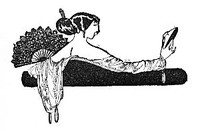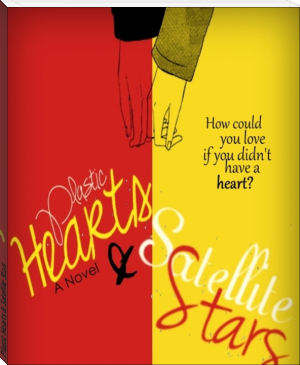Behind the Beyond, and Other Contributions to Human Knowledge, Stephen Leacock [online e reader .TXT] 📗

- Author: Stephen Leacock
Book online «Behind the Beyond, and Other Contributions to Human Knowledge, Stephen Leacock [online e reader .TXT] 📗». Author Stephen Leacock
It was a fair struggle. The child had its chance and was beaten. The child couldn't dress: the dog could. The child couldn't or wouldn't pray: the dog could,—or at least he learnt how. No doubt it came awkwardly at first, but he set himself to it till nowadays a French dog can enter a cathedral with just as much reverence as his mistress, and can pray in the corner of the pew with the same humility as hers. When you get to know the Parisian dogs, you can easily tell a Roman Catholic dog from a Low Church Anglican. I knew a dog once that was converted,—everybody said from motives of policy,—from a Presbyterian,—but, stop, it's not fair to talk about it,—the dog is dead now, and it's not right to speak[122] ill of its belief, no matter how mistaken it may have been.
However, let that pass, what I was saying was that between the child and the dog, each had its chance in a fair open contest and the child is nowhere.
People, who have never seen, even from the outside, the Parisian world of fashion, have no idea to what an extent it has been invaded by the dog craze. Dogs are driven about in motors and open carriages. They are elaborately clipped and powdered and beribboned by special "coiffeurs." They wear little buckled coats and blankets, and in motors,—I don't feel quite sure of this,—they wear motor goggles. There are at least three or four—and for all I know there may be more—fashionable shops in Paris for dogs' supplies. There is one that any curious visitor may easily find at once in the Rue des Petits Champs close to the Avenue de l'Opera. There is another one midway in the galleries of the Palais Royal. In these shops you will see, in the first place, the chains, collars, and whips that[123] are marks of the servitude in which dogs still live (though, by the way, there are already, I think, dog suffragettes heading a very strong movement). You will see also the most delicious, fashionable dog coats, very, very simple, fastened in front with one silver clasp, only one. In the Palais Royal shop they advertise, "Newest summer models for 1913 in dogs' tailoring." There are also dogs' beds made in wickerwork in cradle shape with eider-down coverlets worked over with silk.
A little while ago, the New York papers were filled with an account of a dog's lunch given at the Vanderbilt Hotel by an ultra-fashionable American lady. It was recorded that Vi Sin, the Pekin Spaniel of Mrs. H. of New York, was host to about ten thousand dollars worth of "smart" dogs. I do not know whether or not this story is true, for I only read it in the Parisian papers. But certain it is that the episode would have made no sensation in Paris. A dog eating in a restaurant is a most ordinary spectacle. Only a few days ago I had lunch with a dog,—a very quiet,[124] sensible Belgian poodle, very simply dressed in a plain morning stomach coat of ultramarine with leather insertions. I took quite a fancy to him. When I say that I had lunch with him, I ought to explain that he had a lady, his mistress, with him,—that also is quite usual in Paris. But I didn't know her, and she sat on the further side of him, so that I confined myself to ordinary table civilities with the dog. I was having merely a plain omelette, from motives of economy, and the dog had a little dish of entrecote d'agneau aux asperges maître d'hôtel. I took some of it while the lady was speaking to the waiter and found it excellent. You may believe it or not, but the entry of a dog into a French restaurant and his being seated at a table and having his food ordered creates not the slightest sensation. To bring a child into a really good restaurant would, I imagine, be looked upon as rather a serious affair.
Not only is the dog the darling of the hour during his lifetime, but even in death he is not forgotten. There is in Paris a special dog[125] cemetery. It lies among the drooping trees of a little island in the Seine, called the Isle de la Recette, and you may find it by taking the suburban tramway for Asnières. It has little tombstones, monuments, and flowered walks. One sorrow-stricken master has inscribed over a dog's grave,—"Plus je vois les hommes, plus j'aime mon chien." The most notable feature of the cemetery is the monument of Barry, a St. Bernard dog. The inscription states that he saved forty lives in the Alps.
But the dog craze is after all only a sign and sample of the prevailing growth and extent of fashionable luxury. Nowhere in the world, I suppose, is this more conspicuous than in Paris, the very Vanity Fair of mundane pleasure. The hostesses of dinners, dances and fêtes vie with one another in seeking bizarre and extravagant effects. Here is a good example of it taken from actual life the other day. It is an account of an "oriental fête" given at a private mansion in Paris.
It runs thus:—"The sumptuous Paris mansion of the Comtesse Aynard de Chabrillan in[126] the Rue Christophe-Colomb was converted into a veritable scene from the 'Thousand and One Nights' on the occasion of a Persian fête given by her to a large company of friends.
"In the courtyard an immense tent was erected, hung with superb Persian stuffs and tapestries, and here the élite of Paris assembled in gorgeous Oriental costumes.
"The countess herself presided in a magnificent Persian costume of green and gold, with an immense white aigrette in her hair."
Notice it. The simplicity of it! Only green and gold in her costume, no silver, no tin, no galvanized iron, just gold, plain gold; and only "one immense white aigrette." The quiet dignity of it!
The article goes on:—"Each of the sensational entries was announced by M. André de Fouquières, the arbiter of Parisian elegance.
"One of the most striking spectacles of the evening was the appearance of Princesse P. d'Arenberg, mounted on an elephant, richly bedecked with Indian trappings. Then came the Duchesse de Clermont-Tonnerre and the[127] Comtesse Stanislas de Castellane in gold cages, followed by the Marquise de Brantes, in a flower-strewn Egyptian litter, accompanied by Pharaoh and his slaves.
"The Comtesse de Lubersac danced an Oriental measure with charming grace, and Prince Luis Fernando of Spain, in an ethereal costume, his features stained a greenish hue, executed a Hindoo dance before the assembly."
Can you beat it? His features stained with a greenish hue! Now look at that! He might have put on high grade prepared paint or clear white lead,—he's rich enough,—but, no, just a quiet shingle stain is enough for him.
I cannot resist adding from the same source the list of the chief guests. Anybody desiring a set of names for a burlesque show to run three hundred nights on the circuit may have them free of charge or without infringement of copyright.
"Nearly everyone prominent in Paris society was present, including the Maharajah of Kapurthala, Princess Prem Kaur, Prince Aga Khan, the Austrian Ambassador and Countess[128] Szecsen, the Persian and Bulgarian Ministers, Mme. Stancioff, Duc and Duchesse de Noailles, Comtesse A. Potocka, Marquis and Marquise de Mun, Comtesse du Bourg de Bozas, Mrs. Moore, Comte and Comtesse G. de Segonzec and Prince and Princess de Croy."
I am sorry that "Mrs. Moore" was there. She must have slipped in unnoticed.
What is not generally known is that I was there myself. I appeared,—in rivalry with Prince Luis Fernando—dressed as a Bombay soda water bottle, with aerial opalescent streaks of light flashing from the costume which was bound with single wire.[129]
IV.—A Visit to Versailles"WHAT!" said the man from Kansas, looking up from his asparagus, "do you mean to say that you have never seen the Palace of Versailles?"
"No," I said very firmly, "I have not."
"Nor the fountains in the gardens?"
"No."
"Nor the battle pictures?"
"No."
"And the Hall of Mirrors,"—added the fat lady from Georgia.
"And Madame du Barry's bed"—said her husband.
"Her which," I asked, with some interest.
"Her bed."
"All right," I said, "I'll go."
I knew, of course, that I had to. Every tourist in Paris has got to go and see Versailles. Otherwise the superiority of the others becomes insufferable, with foreigners it is[130] different. If they worry one about palaces and cathedrals and such—the Château at Versailles, and the Kaiserhof and the Duomo at Milan—I answer them in kind. I ask them if they have ever seen the Schlitzerhof at Milwaukee and the Anheuserbusch at St. Louis, and the Dammo at Niagara, and the Toboggo at Montreal. That quiets them wonderfully.
But, as I say, I had to go.
You get to Versailles—as the best of various ways of transport—by means of a contrivance something between a train and a street car. It has a little puffing steam-engine and two cars—double deckers—with the top deck open to the air and covered with a wooden roof on rods. The lower part inside is called the first-class and a seat in it costs ten cents extra. Otherwise nobody would care to ride in it. The engine is a quaint little thing and wears a skirt, painted green, all around it, so that you can just see the tips of its wheels peeping modestly out below. It was a great relief to me to see this engine. It showed that there[131] is such a thing as French delicacy after all. There are so many sights along the boulevards that bring the carmine blush to the face of the tourist (from the twisting of his neck in trying to avoid seeing them), that it is well to know that the French draw the line somewhere. The sight of the bare wheels of an engine is too much for them.
The little train whirls its way out of Paris, past the great embankment and the fortifications, and goes rocking along among green trees whose branches sweep its sides, and trim villas with stone walls around quaint gardens. At every moment it passes little inns and suburban restaurants with cool arbours in front of them, and waiters in white coats pouring out glasses of red wine. It makes one thirsty just to look at them.
In due time the little train rattles and rocks itself over the dozen miles or so that separate Paris from Versailles, and sets you down right in front of the great stone court-yard of the palace. There through the long hours of a summer afternoon you may feast your eyes[132] upon the wonderland of beauty that rose at the command of the grand monarch, Louis XIV, from the sanded plains and wooded upland that marked the spot two hundred and fifty years ago.
All that royal munificence could effect was lavished on the making of the palace. So vast is it in size that in the days of its greatest splendour it harboured ten thousand inmates. The sheer length of it from side to side is only about a hundred yards short of half a mile. To make the grounds the King's chief landscape artist and his hundreds of workers laboured for twenty years. They took in, as it were, the whole landscape. The beauty of their work lies not only in the wonderful terraces, gardens, groves and fountains that extend from the rear of the Château, but in its blending with the scene beyond. It is so planned that no distant house or building breaks into the picture. The vista ends everywhere with the waving woods of the purple distance.
Louis XIV spent in all, they say, a hundred[133] million dollars on the making of the palace. When made it was filled with treasures of art not to be measured in price. It was meant to be, and it remains, the last word of royal grandeur. The King's court at Versailles became the sun round which gravitated the fate and fortune of his twenty million subjects. Admission within its gates was itself a mark of royal favour. Now, any person with fifteen cents may ride out from Paris on the double-decked street car and wander about the palace at will. For a five cent tip to a guide you may look through the private apartments of Marie Antoinette, and for two cents you may check your umbrella while you inspect the bedroom of Napoleon the First. For nothing at all you may stand on the vast terrace behind the Château and picture to yourself the throng of gay ladies in paniered skirts, and powdered gentlemen, in sea-green inexpressibles, who walked among its groves and fountains two hundred years ago. The palace of the Kings has become the playground of the democracy.[134]
The palace—or





Comments (0)